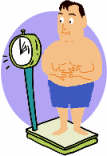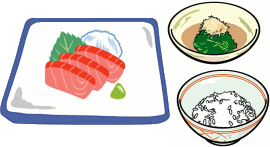いま、1型糖尿病は
2008年02月06日
32Dishing Up Food On Large Plates....

Everyone is putting on weight
Lately, the young, the middle-aged and the senior seem to be all gaining weight. On the other hand, I see a lot of young slender ladies. However, when I carefully observed young ladies walking on a main street during the summer, paying attention to their bellies, I realized the area around their navel plumping out. They look slender on the surface, but they do have excess fat on their bellies.
In general, Japanese people are becoming a little fatter.
Some people go on an extreme diet, sometimes obsessively, and that is another problem.
Speaking of diabetes patients, they often find it difficult to produce good results in weight control even if they are eating while paying attention to the disease. It may actually be rare that they can achieve good weight control.
Even with nutritional guidance
Diabetes patients, whether type 1 or 2 learn about energy content of diet, daily calorie intake for the average Japanese, and food high in carbohydrate, protein or fat. Then, an appropriate daily calorie intake is determined for each patient, and patients learn from nutritionists about how to consume a meal that matches the set calories.
Of course, diet therapy that is hard even for nutritionists to follow would not work. (Patients will not be able to follow such diet therapy.) Patients start with what they can do. Though nutritionists teach them what to eat and how much in a single meal, it is often difficult for them to put it into practice.
<>
Nutritional guidance not producing desirable results
I often wonder why some patients do not do well on diet therapy whereas others do well. It is not that those not doing well are following a very strict diet or that they are not motivated.

Serving single portions on small plates for each family member
In some families, food is dished up on large plates and laid out on a dining table. It is certainly easier to use large plates because each family member needs only two other small plates or so to take his/her food, leaving not too many dishes to wash.
However, if you take food from large plates, you will never know how much you have actually eaten even if you have learned well from your nutritionist how much to eat per meal. You will lose track of the amount once you start eating since you take your food from large plates. On the other hand, if your single portions of food are served on small plates from the beginning, you will then know how much you ate. You will also be less likely to eat too much.
This was how Japanese people use to eat. I wonder since when this style of serving food on large plates for share started.
This style has been actually practiced by many of those having difficulty in making progress on diet therapy. Some of them did actually say, "Serving food on large plates seems to be the cause."
Let us try to go back to the way we used to eat - serving single portions on small plates.
©2008 Yasuko Uchigata
食卓で大皿に盛って・・・

スレンダーな若い女性も多くみかけるのですが、この夏、大通りを歩いている若い女性をよく観察してみました。お腹あたりに注視してみましたところ、ぷくっと太っていました。おへそあたりに、ふくらみがあるのです。一見、細身なのですが、やはりお腹あたりに脂肪が付いているのですね。
だれかれいうことなく、太めになってきているといえます。
極端にダイエットする人もいますが、すこし異常なダイエットになってしまうこともあり、これはまた別の問題です。
そうではなくて、糖尿病のことをすこし気をつけながら食事をしているのにもかかわらず、なかなかその成果がでてこないことがよくありますね。成果がでることのほうが少ないかもしれません。
そして、おひとりお一人の適切な1日の摂取エネルギー量が設定されて、そのキロカロリーに見合った食事をどのように摂取したらいいか、栄養士さんに習うことになります。
もちろん、栄養士さん自身もできそうもないような食事療法ではこまります(栄養士さんもできそうでない食事療法をいわれたら、それはできませんね)。できそうなレベルから実践していくことになります。 1回の食事で、なにをこのくらい、と教えてもらうのですが、やはりなかなかできないことが多いですね。

1人ずつ小皿や小鉢におかずを盛りつける
しかし、これでは、自分がどのくらい食べたか、一向にわからないのですね。栄養士さんにしっかりこのくらいの量よ、と習っても、食べ始めたら、わからなくなってしまいます。原因は大皿にありそうです。 食卓のひとりひとりに、小皿や小鉢におかずを盛りつけていただく、この形式のほうが、どれくらい食べたか、よくわかります。食べ過ぎることも、おきにくいと思います。
以前は、ひとりひとりの小皿や小鉢に盛りつけていただいておりました。いつごろからでしょうか。大皿に盛って、そこから自分の小皿に取り分けるようになったのは?
このところ、うまく栄養指導の成果が現れない方の多くに、大皿方式がありました。また、何人かは、「大皿に盛ることが悪いみたいですね」、とおっしゃってくれました。
ぜひ、以前の日本の食卓のように、小皿や小鉢に盛りつける形式の食事をするように、心がけましょう。
※ヘモグロビンA1c(HbA1c)等の表記は記事の公開時期の値を表示しています。
Copyright ©1996-2024 soshinsha. 掲載記事・図表の無断転用を禁じます。
治療や療養についてかかりつけの医師や医療スタッフにご相談ください。

 医療・健康情報グループ検索
医療・健康情報グループ検索